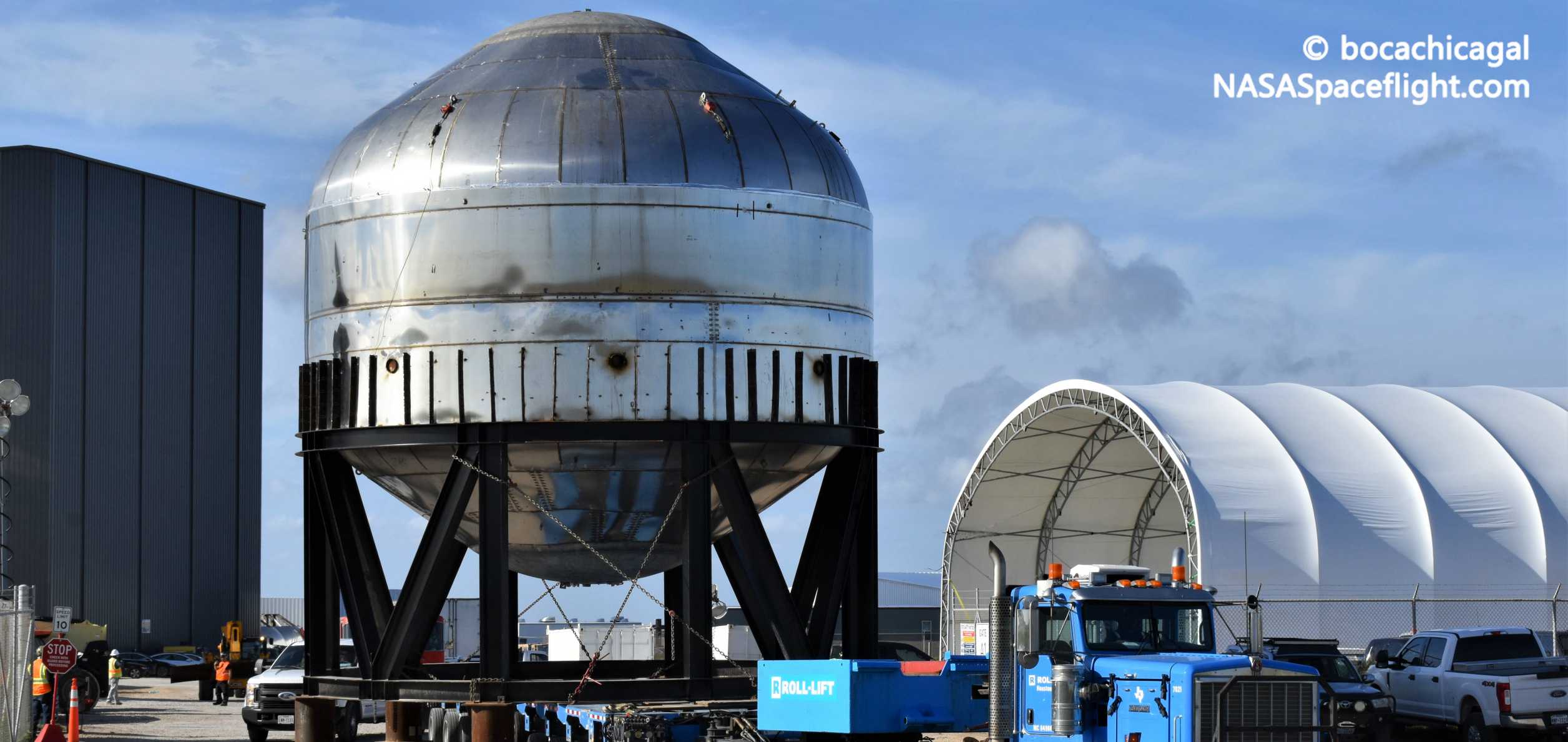

News
SpaceX prepares new Starship tank for explosive test after rapid construction
Over the last few weeks, SpaceX’s South Texas Starship team has been making progress at a pace unprecedented even for the famously agile rocket company and is moving full speed ahead to kick off a new series of explosive tests as early as this morning.
Ever since SpaceX’s original Starship Mk1 prototype spectacularly failed during a November 2019 pressure test, the company has been rapidly rearranging and modifying the development schedule for its next-generation full-reusable rocket. Be it a side effect or coincidence, SpaceX effectively began closing its Florida Starship factory a week after Mk1’s demise and even shipped some of its Florida-built Starship hardware to Texas in recent weeks. However, most of the Florida workforce (up to 80%) was reportedly redirected elsewhere in the company, avoiding layoffs.
Some portion may have even moved to Texas and joined SpaceX’s Starship Boca Chica facilities. Given just how aggressively SpaceX has been expanding its local facilities and preparing new hardware for the next round of improved Starship prototypes, it seems quite likely that the South Texas outpost did indeed receive an influx of skilled workers. Most recently, the company has demonstrated its rapidly growing expertise in the bizarre art of building steel rockets en plein air by fabricating and integrating new tank domes and steel rings and then shipping the curious contraption to its nearby launch site in a matter of weeks from start to finish.
Although it’s difficult to determine the chronology of every single part of the mysterious new tank, it’s fairly safe to say that work on its structure began less than a week before SpaceX CEO Elon Musk tweeted a surprise update, indicating on December 27th that he was in Boca Chica, Texas working all night on “Starship tank dome production”.
In simple terms, the business half of SpaceX’s next-generation Starship upper stage and Super Heavy boosters are comprised of three main parts, shared by almost all launch vehicles. Both are rocket stages that must be as light as physically possible while supporting thousands of tons worth of supercool liquid oxygen and methane propellant. The majority of a simple rocket is ultimately a duo of cylindrical tanks capped by tank domes – also known as bulkheads. The bottom bulkhead of boosters and upper stages also serves as a mounting point for an engine section, where the vehicle’s rocket engines are attached to the rocket body in order to transfer their thrust throughout the rest of the structure.
SpaceX CEO Elon Musk says that Starship tank domes have turned out to be “the most difficult part of [the rocket’s] primary structure” to manufacture, thus explaining why he was apparently assisting the Boca Chica team all night on December 27th.
Starship Mk1 exploded on November 20th, 2019 during a nonflammable propellant loading test, a failure that unofficial videos have compellingly linked to the weld joint connecting the rocket’s upper tank dome to its cylindrical tank. That section of the rocket began leaking cryogenic propellant moments before the entire upper dome tore off the rest of the vehicle and launched hundreds of feet into the air.
All hail Baby Tank
In an apparent response to the unsatisfactory results of Starship Mk1’s manufacturing methods, SpaceX has rapidly initiated an already-planned upgrade of its Starship facilities and manufacturing methods in South Texas, taking delivery of a wealth of new tools over the last several weeks. Most recently, SpaceX’s latest step towards demonstrating that it has substantially improved manufacturing quality arrived in the form of a single propellant tank – the same diameter as Starship Mk1 but much shorter than any possible flight hardware.
Quickly nicknamed Bopper (short for Baby Starhopper) by locals and close followers, the miniature Starship test article came together at a truly spectacular pace. Comprised of two single-weld steel rings and two brand new tank domes, it appears that all four of the components were nothing more than parts and steel stock less than three weeks ago. The first sign of activity came around December 19th, when technicians began placing pressed steel sections onto a bulkhead (dome) assembly jig – used to precisely hold the pieces in the right shape and place as they are welded together.
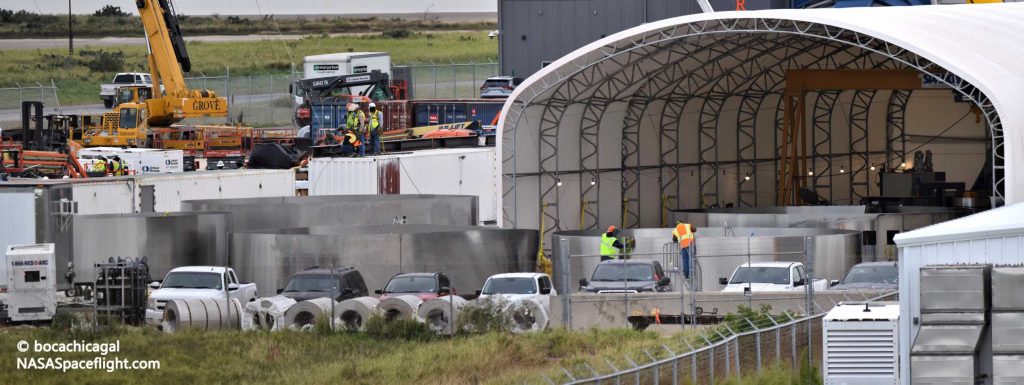
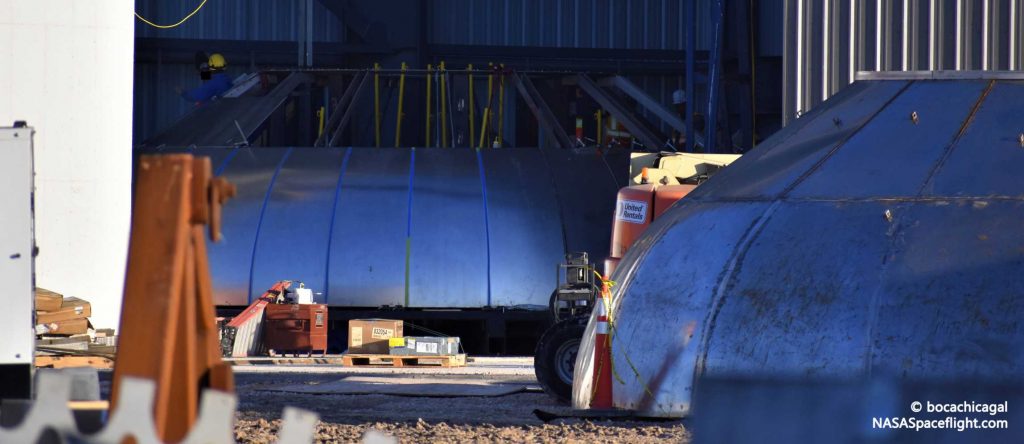
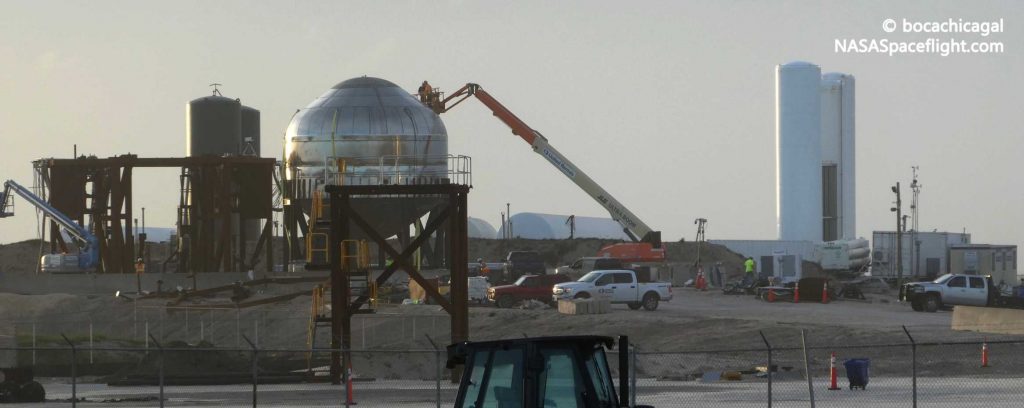
Incredibly, aside from taking less than three weeks to go from miscellaneous parts to an assembled Starship tank delivered to the test site, SpaceX technicians appeared to finish stacking and welding its two halves (each a ring and a dome) perhaps a handful of hours before it was lifted onto a transporter and driven to the launch pad.
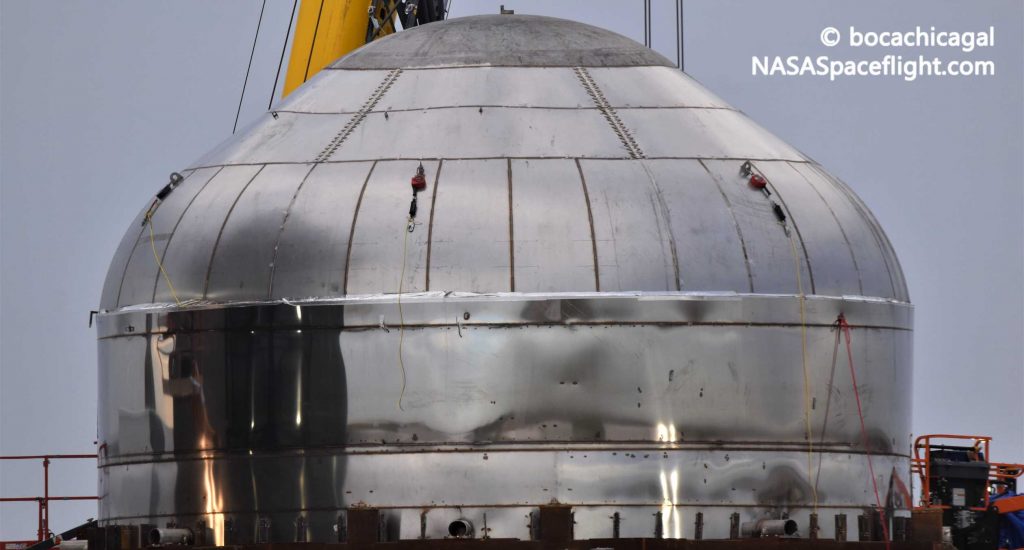
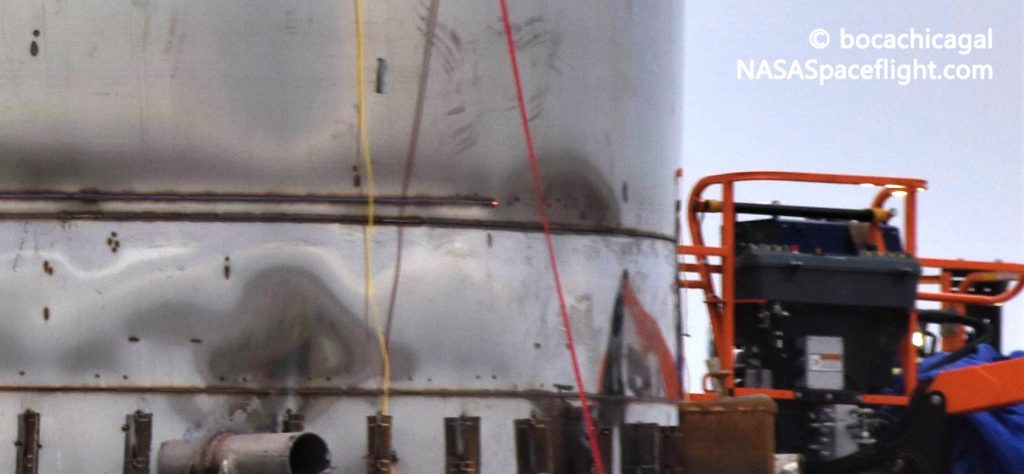
Even for SpaceX, moving a prototype from factory to test site hours after its primary structure was welded together represents an almost unfathomably fast pace of work – truly unfathomable in traditional aerospace. Whether or not such a pace of work is smart, sustainable, or worth it remains to be seen, but SpaceX is nevertheless on track to pressure test its new mini Starship tank as early as this morning, potentially resulting in another spectacular overpressure event (i.e. explosion).
If the tank survives up to or beyond the pressures SpaceX has designed it to, it’s safe to say that the next full-scale Starship prototype could come together far sooner than almost anyone might have expected.
Check out Teslarati’s Marketplace! We offer Tesla accessories, including for the Tesla Cybertruck and Tesla Model 3.
News
These Tesla, X, and xAI engineers were just poached by OpenAI
The news is the latest in an ongoing feud between Elon Musk and the Sam Altman-run firm OpenAI.

OpenAI, the xAI competitor for which Elon Musk previously served as a boardmember and helped to co-found, has reportedly poached high-level engineers from Tesla, along with others from xAI, X, and still others.
On Tuesday, Wired reported that OpenAI hired four high-level engineers from Tesla, xAI, and X, as seen in an internal Slack message sent by co-founder Greg Brockman. The engineers include Tesla Vice President of Software Engineering David Lau, X and xAI’s head of infrastructure engineering Uday Ruddarraju, and fellow xAI infrastructure engineer Mike Dalton. The hiring spree also included Angela Fan, an AI researcher from Meta.
“We’re excited to welcome these new members to our scaling team,” said Hannah Wong, an OpenAI spokesperson. “Our approach is to continue building and bringing together world-class infrastructure, research, and product teams to accelerate our mission and deliver the benefits of AI to hundreds of millions of people.”
Lau has been in his position as Tesla’s VP of Software Engineering since 2017, after previously working for the company’s firmware, platforms, and system integration divisions.
“It has become incredibly clear to me that accelerating progress towards safe, well-aligned artificial general intelligence is the most rewarding mission I could imagine for the next chapter of my career,” Lau said in a statement to Wired.
🚨Optimistic projections point to xAI possibly attaining profitability by 2027, according to Bloomberg's sources.
If accurate, this would be quite a feat for xAI. OpenAI, its biggest rival, is still looking at 2029 as the year it could become cash flow positive.💰 https://t.co/pE5Z9daez8
— TESLARATI (@Teslarati) June 18, 2025
READ MORE ON OPENAI: Elon Musk’s OpenAI lawsuit clears hurdle as trial looms
At xAI, Ruddarraju and Dalton both played a large role in developing the Colossus supercomputer, which is comprised of over 200,000 GPUs. One of the major ongoing projects at OpenAI is the company’s Stargate program,
“Infrastructure is where research meets reality, and OpenAI has already demonstrated this successfully,” Ruddarraju told Wired in another statement. “Stargate, in particular, is an infrastructure moonshot that perfectly matches the ambitious, systems-level challenges I love taking on.”
Elon Musk is currently in the process of suing OpenAI for shifting toward a for-profit model, as well as for accepting an investment of billions of dollars from Microsoft. OpenAI retaliated with a counterlawsuit, in which it alleges that Musk is interfering with the company’s business and engaging in unfair competition practices.
Elon Musk confirms Grok 4 launch on July 9 with livestream event
News
SpaceX share sale expected to back $400 billion valuation
The new SpaceX valuation would represent yet another record-high as far as privately-held companies in the U.S. go.

A new report this week suggests that Elon Musk-led rocket company SpaceX is considering an insider share sale that would value the company at $400 billion.
SpaceX is set to launch a primary fundraising round and sell a small number of new shares to investors, according to the report from Bloomberg, which cited people familiar with the matter who asked to remain anonymous due to the information not yet being public. Additionally, the company would sell shares from employees and early investors in a follow-up round, while the primary round would determine the price for the secondary round.
The valuation would represent the largest in history from a privately-owned company in the U.S., surpassing SpaceX’s previous record of $350 billion after a share buyback in December. Rivaling company valuations include ByteDance, the parent company of TikTok, as well as OpenAI.
Bloomberg went on to say that a SpaceX representative didn’t respond to a request for comment at the time of publishing. The publication also notes that the details of such a deal could still change, especially depending on interest from the insider sellers and share buyers.
Axiom’s Ax-4 astronauts arriving to the ISS! https://t.co/WQtTODaYfj
— TESLARATI (@Teslarati) June 26, 2025
READ MORE ON SPACEX: SpaceX to decommission Dragon spacecraft in response to Pres. Trump war of words with Elon Musk
SpaceX’s valuation comes from a few different key factors, especially including the continued expansion of the company’s Starlink satellite internet company. According to the report, Starlink accounts for over half of the company’s yearly revenue. Meanwhile, the company produced its 10 millionth Starlink kit last month.
The company also continues to develop its Starship reusable rocket program, despite the company experiencing an explosion of the rocket on the test stand in Texas last month.
The company has also launched payloads for a number of companies and government contracts. In recent weeks, SpaceX launched Axiom’s Ax-4 mission, sending four astronauts to the International Space Station (ISS) for a 14-day stay to work on around 60 scientific experiments. The mission was launched using the SpaceX Falcon 9 rocket and a new Crew Dragon capsule, while the research is expected to span a range of fields including biology, material and physical sciences, and demonstrations of specialized technology.
News
Tesla Giga Texas continues to pile up with Cybercab castings
Tesla sure is gathering a lot of Cybercab components around the Giga Texas complex.

Tesla may be extremely tight-lipped about the new affordable models that it was expected to start producing in the first half of the year, but the company sure is gathering a lot of Cybercab castings around the Giga Texas complex. This is, at least, as per recent images taken of the facility.
Cybercab castings galore
As per longtime drone operator Joe Tegtmeyer, who has been chronicling the developments around the Giga Texas complex for several years now, the electric vehicle maker seems to be gathering hundreds of Cybercab castings around the factory.
Based on observations from industry watchers, the drone operator appears to have captured images of about 180 front and 180 rear Cybercab castings in his recent photos.
Considering the number of castings that were spotted around Giga Texas, it would appear that Tesla may indeed be preparing for the vehicle’s start of trial production sometime later this year. Interestingly enough, large numbers of Cybercab castings have been spotted around the Giga Texas complex in the past few months.
Cybercab production
The Cybercab is expected to be Tesla’s first vehicle that will adopt the company’s “unboxed” process. As per Tesla’s previous update letters, volume production of the Cybercab should start in 2026. So far, prototypes of the Cybercab have been spotted testing around Giga Texas, and expectations are high that the vehicle’s initial trial production should start this year.
With the start of Tesla’s dedicated Robotaxi service around Austin, it might only be a matter of time before the Cybercab starts being tested on public roads as well. When this happens, it would be very difficult to deny the fact that Tesla really does have a safe, working autonomous driving system, and it has the perfect vehicle for it, too.
-

 Elon Musk1 week ago
Elon Musk1 week agoTesla investors will be shocked by Jim Cramer’s latest assessment
-

 News2 weeks ago
News2 weeks agoTesla Robotaxi’s biggest challenge seems to be this one thing
-

 Elon Musk1 day ago
Elon Musk1 day agoElon Musk confirms Grok 4 launch on July 9 with livestream event
-

 News2 weeks ago
News2 weeks agoWatch the first true Tesla Robotaxi intervention by safety monitor
-

 News5 days ago
News5 days agoTesla Model 3 ranks as the safest new car in Europe for 2025, per Euro NCAP tests
-

 Elon Musk2 weeks ago
Elon Musk2 weeks agoA Tesla just delivered itself to a customer autonomously, Elon Musk confirms
-

 Elon Musk2 weeks ago
Elon Musk2 weeks agoElon Musk confirms Tesla Optimus V3 already uses Grok voice AI
-

 Elon Musk2 weeks ago
Elon Musk2 weeks agoxAI welcomes Memphis pollution results, environmental groups push back

















